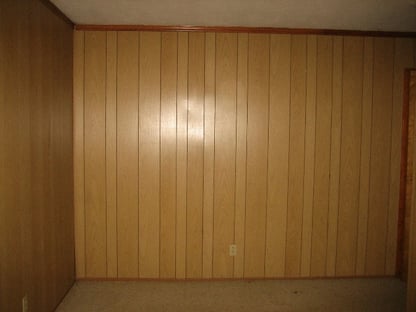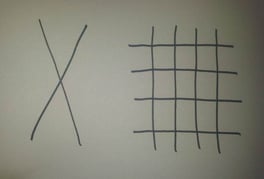Do The Pros Recommend Painting Paneling ?
Jeremy Holderness Modern day ceiling-to-floor interior wall paneling that's sold in 4'x8' sheets first rose to popularity in the U.S. back in the 1950's and retained its popularity through the 1970's.
Modern day ceiling-to-floor interior wall paneling that's sold in 4'x8' sheets first rose to popularity in the U.S. back in the 1950's and retained its popularity through the 1970's.
You know the stuff -- it's usually made out of cheap particle board or lauan with a thin veneer on the finish side that's designed to look like individual wood boards, or sometimes even wallpapered walls or imitation brick.
It was sold as an inexpensive alternative to drywall or real wood interior panels. Since it only requires a few nails to attach it to the wall studs, a person can go from an unfinished space to finished walls in a matter of no time. Although its popularity has declined significantly, you can still purchase paneling sheets at most home centers for just a few bucks each.
Despite its ease of use and cost-effectiveness, there is little arguing the point that when you walk into someone's house who's sporting paneling walls it makes the home look "dated". And if you're the one with the paneling walls in your home there very likely may come a time when you're ready for an updated look.
You could order a construction dumpster and have it delivered to your residence, then start tearing the panels down, sheet by sheet. But unless you're skilled in drywall hanging and finishing you'll need to hire a contractor to come in and make your place look livable again -- and it won't come cheap nor without creating a major mess.
So what about painting paneling ?
You Can't Paint Paneling...Can You?
These days you can paint just about anything, and paneling is no different. The question is..."Can you paint paneling and make it look good?" And equally as important -- "How do you paint paneling and make it last?"
When my family and I moved into our most recent home we were faced with this very issue that needed to be dealt with. The entire house had circa 1985 paneling walls which were visually displeasing to say the least. So one of the first things we did was start the process of painting everything in sight.
The "Stick" Test - Feeling confident that the project would turn out well, before we got too carried away, we wanted to make sure that that we would get good adhesion onto the paneling with our paint.
 I took a little pre-paint cleaner and cleaned a 12"x12" spot in a couple different rooms. Then we applied test patches over the prepared areas, allowing each of them to dry for several days.
I took a little pre-paint cleaner and cleaned a 12"x12" spot in a couple different rooms. Then we applied test patches over the prepared areas, allowing each of them to dry for several days.
Next we took a razor knife and scored a pattern into the coating all the way through to the substrate below. One x-pattern and one cross-hatch pattern in each area gave us a good indication of how well our adhesion is going to be.
Next I applied some good quality clear packing tape over each of the patterns and rubbed them using firm pressure against the wall surface. Finally I peel up an edge of the tape and start pulling it off at an angle of about 180 degrees away from the edge where I started peeling from the wall.
If all goes as planned I will get little to no paint that comes off with my tape. If I get a significant amount coming off with my tape removal, then I need to be thinking about applying a coat of a good adhesion-promoting primer, such as Zinsser's Bullseye 1-2-3.
Preparing The Paneling For Paint - Assuming all goes well with the adhesion test, we'll do a thorough cleaning of the walls with a good pre-paint primer. While most people will never clean their interior walls before they re-paint, it is much more important when you're dealing with a surface that's likely never been painted.
After the paneling has had a chance to completely dry, the only other consideration that should be given before rolling on a couple of coats is to caulk all of the cracks where each sheet meets one another, as well as where the paneling meets the trim (baseboard, door & window casing, etc.) so you'll have more of a seamless look when the project is completed. Ideally caulking should not be applied to a bare surface that hasn't either been primed or previously painted, so if you're concerned about your caulking adhering, you could spot prime all of those areas where you plan to caulk, or you could just take your chances.
Painting The Walls - There's really nothing special about painting paneling vs painting drywall walls. The only thing you'll want to pay attention to is making sure that all of those vertical lines get covered. Using a roller cover with a 1/2" nap will usually do the trick.
Other Types Of Paneling
There are a couple other types of paneling that are more challenging to paint over than the standard stuff.
Wallpaper Paneling - This is exactly what it sounds like it is -- wooden paneling with a layer of wallpaper applied to the surface rather than a wood veneer. While we typically don't recommend painting over wallpaper, it's not advisable to attempt to remove the wallpaper from the paneling to paint it, so if this is your only other option shy of tearing all of the paneling out then I'd say go for it. This article will show you how to paint over wallpaper.
Marlite Paneling - Fiberglass reinforced plastic paneling (commonly referred to as Marlite) is a type of paneling that has a very "slick" surface and it's often seen in wet areas such as bathrooms. You've probably seen the type that's been stamped to look like tile. If so, that's Marlite.
This stuff can be trickier to paint because it's difficult to get paints to adhere to it. You'll want to clean the surface as I described earlier. Use some medium grit sandpaper to rough-up the surface, then wipe it down with a damp rag to remove any dust. Apply a coat of a good quality bonding primer that will adhere to plastic and/or fiberglass. Then put on two coats of your finish paint.
If you would like some assistance with your house painting project please give us a call at (813) 570-8800, visit our Contact Us page, or click on the button below to request your free, no-obligation consultation and quote.








